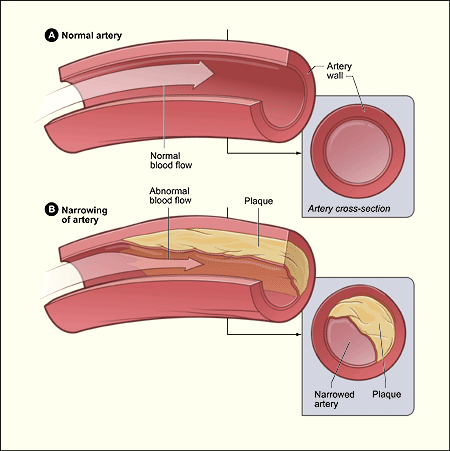
- Coronary artery disease (CAD) is plaque buildup in the arteries of your heart.
- Peripheral artery disease (PAD) most often is plaque buildup in the arteries of the legs, but it can also build up in your arms or pelvis.
- Carotid artery disease is plaque buildup in the neck arteries. It reduces blood flow to the brain.
- Renal artery stenosis is plaque buildup in the arteries that supply blood to your kidneys.
- Vertebral artery disease is atherosclerosis in the arteries that supply blood to the back of the brain. This area of the brain controls body functions that are needed to keep you alive. Read more about disorders affecting blood supply to the back of the brain.external link
- Mesenteric artery is plaque buildup in the arteries that supply the intestines with blood. Learn more about plaque buildup in the mesenteric arteries external link.
Early stages of atherosclerosis often do not develop with symptoms. Symptoms may first appear when you’re under physical or emotional stress — times when the body needs more oxygen.
What Symptoms Does Atherosclerosis Cause?
- Chest pain (angina), cold sweats, dizziness, extreme tiredness, heart palpitations (feeling that your heart is racing), shortness of breath, nausea and weakness are all symptoms of coronary heart disease.
- Pain, aching, heaviness, or cramping in the legs when walking or climbing stairs are the main symptoms of peripheral artery disease. The symptoms also go away after rest.
- Problems with thinking and memory, weakness or numbness on one side of the body or face, and vision trouble are all early symptoms of vertebral artery disease. Transient ischemic attack (TIA), commonly called a mini-stroke, is a more serious symptom.
- Severe pain following meals, weight loss, and diarrhea are symptoms of mesenteric artery of the intestines.
- Erectile dysfunction (ED) is an early warning sign that a man may be at higher risk for atherosclerosis and its complications. If you have ED, talk with your healthcare team about your risk of plaque buildup,
- Plaque buildup in the arteries of the neck (carotid artery disease) can cause a bruit. This is a whooshing sound that your doctor hears when using a stethoscope. Severe symptoms of a bruit include a transient ischemic attack (TIA).
- Using a stethoscope, doctors may hear a bruit in your belly, which is an early sign of plaque buildup in the arteries that deliver blood to the kidneys (renal artery stenosis). As the disease worsens, it can cause high blood pressure, extreme tiredness, loss of appetite, nausea (feeling sick to the stomach), swelling in the hands or feet, and itchiness or numbness.
Screening Tests
Beginning at age 20, your doctor will regularly check to see if you have risk factors for plaque buildup in the arteries. Your doctor may:- Check your blood pressure.
- Calculate your body mass index and measure your waist to see whether you have an unhealthy weight.
- Order blood tests to see whether you have unhealthy blood cholesterol or triglycerides levels, or diabetes.
Estimating your Risk
Talk with your healthcare provider about risk factors:- Lifestyle habits, such as smoking or vaping, physical activity, and eating habits
- Your personal health history, of medical conditions that may affect your risk, including diabetes and conditions, such as rheumatoid arthritis and psoriasis
- Your family history, if you have blood relatives who had heart attacks or died suddenly before they were 55 years old
Diagnostic Tests
To diagnose atherosclerosis, your doctor may order tests. Your doctor may recommend tests even if you do not have symptoms. The type of test depends on which arteries are affected by plaque buildup.Blood Tests
Blood tests check the levels of cholesterol, , blood sugar, , or proteins that are signs of , such as C-reactive protein.Electrocardiogram
An electrocardiogram, also called an ECG or EKG, is a simple, painless test that detects and records your heart’s electrical activity. An EKG can show how fast your heart is beating, whether the rhythm of your heartbeats is steady or irregular, and the strength and timing of the electrical impulses passing through each part of your heart. You may have an EKG as part of a routine exam to screen for heart disease.An EKG may be recorded in a doctor’s office, an outpatient facility, in a hospital before major surgery, or as part of stress testing. For the test, you will lie still on a table. A nurse or technician will attach up to 12 electrodes to the skin on your chest, arms, and legs. Your skin may need to be shaved to help the electrodes stick. The electrodes are connected by wires to a machine that records your heart’s electrical activity on graph paper or on a computer. After the test, the electrodes will be removed.
Heart Imaging Tests
Your doctor may order a heart imaging test to take pictures of your heart and find problems in blood flow in the heart or coronary arteries.- Angiography is a special type of X-ray using a dye. This procedure can be used to check the arteries in the heart, neck, brain, or other areas of the body.
- Cardiac MRI(magnetic resonance imaging) detects tissue damage or problems with blood flow in the heart or coronary arteries. Cardiac MRI can help explain results from other imaging tests such as chest X-rays and CT scans.
- Cardiac positron emission tomography (PET) scanning assesses blood flow through the small blood vessels of the heart. This is a type of nuclear heart scan that can diagnose coronary microvascular disease.
- Coronary computed tomographic (CT) angiography shows the insides of your coronary arteries rather than an invasive cardiac catheterization. It is a noninvasive imaging test using CT scanning.
Coronary Calcium Scan
A coronary calcium scan is a CT scan of your heart that measures the amount of calcium in the walls of your coronary arteries. Buildup of calcium, or calcifications, are a sign of atherosclerosis or coronary heart disease.A coronary calcium scan may be done in a medical imaging facility or hospital. The test does not use contrast dye and will take about 10 to 15 minutes to complete. A coronary calcium scan uses a special scanner such as an electron beam CT or a multi-detector CT (MDCT) machine. An MDCT machine is a much faster CT scanner that makes high-quality pictures of the beating heart. A coronary calcium scan will determine an Agatston score that reflects the amount of calcium found in your coronary arteries. A score of zero is normal. In general, the higher your score, the more likely you are to have heart disease. If your score is high, your doctor may recommend more tests.
Stress Tests
A stress test measures how healthy your heart is and how well it works during physical stress. Some heart problems are easier to identify when your heart is working hard to pump blood throughout your body, such as when you exercise.Ankle-Brachial Index (ABI) Test
Ankle-brachial index (ABI) tests are used to diagnose peripheral artery disease. This painless test compares the blood pressures in your ankle and your arm using a blood pressure cuff and device.Causes and Risk Factors
Risk factors are conditions or habits that make a person more likely to develop a disease. Nearly half of Americans have high blood pressure or unhealthy cholesterol levels, or they smoke. These are key risk factors that can trigger the start of plaque buildup.What Causes Atherosclerosis?
Plaque buildup in the arteries starts with damage to the arteries. Risk factors such as unhealthy lifestyle habits, medical conditions, or your genes, can lead to this damage.What Raises the Risk of Atherosclerosis?
The risk factors for plaque buildup are often linked. For example, smoking and a lack of regular physical activity raises your risk of unhealthy levels of cholesterol, which can lead to plaque buildup.
- High blood pressure: Over time, high blood pressure can damage artery walls, allowing plaque to build up.
- Diabetes: High blood sugar can damage the inner layers of the arteries, causing plaque buildup.
- Metabolic syndrome: High levels of cholesterol and triglycerides in your blood increase your risk.
- Unhealthy diet: Eating a lot of foods high in saturated fats can increase your cholesterol levels.
- Family history: Your may increase your risk, especially if you have a common cholesterol disorder called familial hypercholesterolemia.
- Inflammatory diseases: When you have conditions such as rheumatoid arthritis and psoriasis, high levels of inflammation can end up irritating your blood vessels, which can lead to plaque buildup.
- Older age: For most people, plaque buildup starts in childhood and gets worse as they get older. In men, the risk increases after age 45. In women, the risk increases after age 55. The risk for women is even higher if you have endometriosis or polycystic ovary syndrome, or if you had gestational diabetes or preeclampsia during pregnancy.





